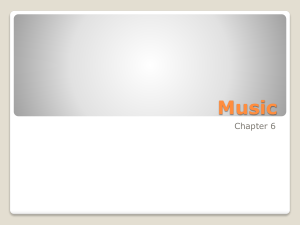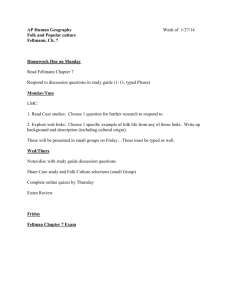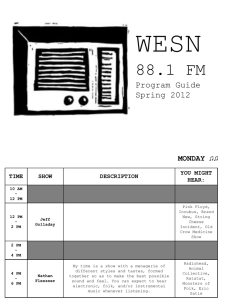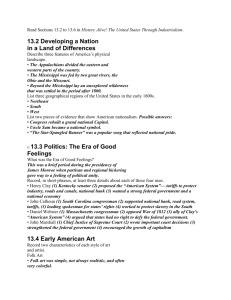American responses
advertisement
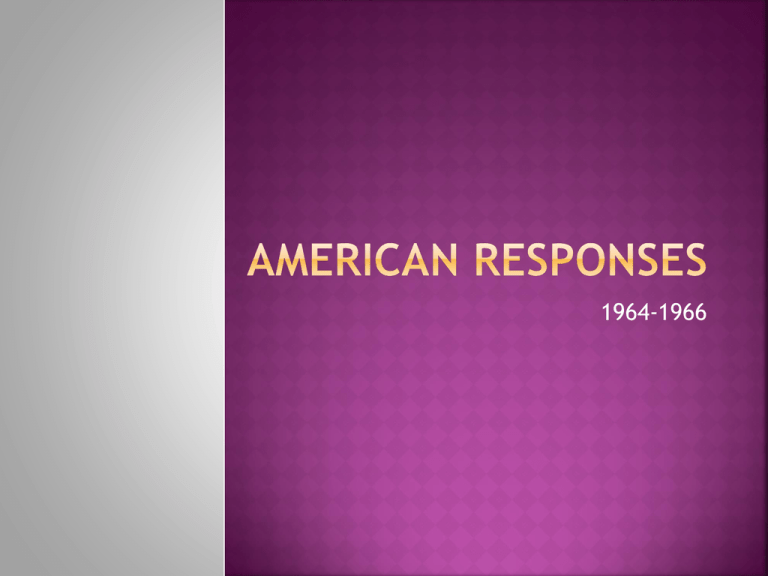
1964-1966 Musicians’ response was one of inspired attempts to imitate and innovate A. 1. Established artists (Phil Spector, The Beach Boys, The Four Seasons, Motown artists) continued with what they were already doing and enjoyed much commercial success. There was a music industry shift away from New York toward Los Angeles B. 1. 2. The television industry (Hollywood) began producing pop music variety shows (Paul Revere and the Raiders) A TV sitcom was developed around the Beatles film A Hard Day’s Night featuring The Monkees. Folk groups and artists moved to L.A., but most signed with New York labels Ironically, the New York labels had ignored them when they were in New York. 3. 4. By 1965 new American pop styles began to appear C. Former styles were being merged with Beatlesoriented “beat” music Most obvious example is folk rock 1. 2. a) b) c) d) 3. Folk is simple Easily accessible to amateur musicians Lyrics dominate the style Electric instruments win over acoustic Earliest artists were Bob Dylan and The Byrds: both added electric guitars, bass, drums, and sometimes keyboards. 4. 5. The folk revival was based on guitar chords accompanying vocals The Beatles were originally a guitar-based ensemble a) b) 6. Transition from acoustic to electric is easy. Wanna-be/would-be musicians bought electric guitars and started practicing in garages The combination of imitation and adaptation of preexisting styles is best seen in folk rock. Bob Dylan in 1964 A. Well-known in the folk music community, but relatively unknown to the pop mainstream audience 1. a) b) 2. 3. Folk artists weren’t part of the “singles” end of the industry Known for their albums of folk music At this time, the folk music that had high exposure was by pop-oriented folk artists such as Peter, Paul and Mary and The Kingston Trio Dylan’s recording success was based on album sales which were fueled by touring on college campuses and in folk clubs Built his style around that of Woody Guthrie 4. a) b) c) Added new lyrics to familiar public domain folk songs Lyrics were about social injustice Heroes of Guthrie songs were real people, not folklore Early Dylan songs dealt with social issues 5. a) b) “Blowin’ in the Wind” about Civil Rights “Masters of War” about Vietnam Eventually Dylan began addressing more personal ideas 6. a) b) He put his talent for crafting lyrics into these relationship-driven topics These lyrics were far more poetic than Brill Building songs Dylan after 1964 B. He wanted to use electric instruments, but wasn’t satisfied with his early attempts The Byrds released an electric version of his “Mr. Tambourine Man” in 1965 1. 2. a) b) 3. The Byrds used a Rickenbacker electric 12-string for the hook and accompaniment—Dylan liked what he heard He decided to try electric again Bringin’ It All Back Home was half electric/half acoustic Electric Dylan and the Newport Folk Festival controversy C. 1. Appeared ate Newport in July 1965 using electric instruments on some songs Folk purists accused him of selling out to the pop mainstream Dylan’s next single, “Like a Rolling Stone” used electric instruments. His next single, “Positively 4th Street” was an angry, “finger-pointing” song. 2. 3. 4. a) b) c) 5. About social injustice that pointed out the perpetrators He was accusing the folk music establishment of unfair criticism He takes 12 verses to express his anger His last album of 1966 was Blonde on Blonde on which he used a band named the Hawks as his backups. They then changed their name to the Band. Dylan spent several months recovering from a near-fatal motorcycle accident in July of 1966. 6. a) b) 7. His albums inspired musicians to follow his path They used electric instuments to accompany lyrics about serious issues Dylan was gone for awhile, but folk rock was continued by other, more commercial artists. “Times They are-AChangin’” & “Like a Rolling Stone” by Bob Dylan. Genre: Folk Rock First international folk rock hit was a cover of Dylan’s “Mr. Tambourine Man” A. 1. 2. 3. B. Byrds were formed in Los Angeles in 1964 Roger (Jim) McGuinn-guitar and vocals, Gene Clark-vocals, David Crosby-guitar and vocals, Chris Hillman-bass and vocals, Michael Clarkedrums Manager Jim Dickson taped their rehearsals and had them listen to themselves Rickenbacker electric 12-string guitar and folk rock The Byrds saw the Beatles film A Hard Day’s Night 1. a) b) c) George Harrison plays the guitar in the movie It was only the second one ever made McGuinn traded his acoustic for a Rickenbacker similar to Harrison’s Their trademark sound was instantly recognizable 2. a) b) Twelve-string electric Rich, textured, harmonized vocals using full and falsetto voices Recorded rock versions of folk songs and some originals 3. a) Covered Bob Dylan songs, Pete Seeger songs, and some originals that were mostly written by Gene Clark When Dylan began writing folk rock songs, the Byrds lost their best source of material C. Forced the Byrds into writing their own folk rock songs They started exploring other styles, especially jazz 1. 2. a) b) Their next song was “Eight Miles High” written by McGuinn, Clark, and Crosby Inspiration was from John Coltrane’s “India” for guitar solos Radio stations quit playing the song when a magazine said the song was about drugs 3. a) b) The lyrics referred to cruising high altitudes for a transatlantic flight The word “high” was code for being under the influence of drugs—double entendre was too clear The Byrds’ 4th album showed a wide spectrum of stylistic influences 4. a) b) c) d) Country Jazz Avant-garde Psychedelia “Eight Miles High” by The Byrds Genre: Folk Rock “Mr. Tambourine Man” is interesting convergence of music business aspects A. The entire band is not playing on the record 1. a) b) c) d) e) f) McGuinn plays the electric 12-string McGuinn and Crosby sing The rest of the track is provided by Phil Spector’s “Wrecking Crew” studio musicians The Wrecking Crew used the same groove they used on a Brian Wilson Song The idea of using studio musicians is a Brill Building concept McGuinn had worked in the Brill Building as a songwriter for teen idol Bobby Darin 2. 3. 4. McGuinn claims to have been inspired by a Bach Chorale—the electric hook is melodically more similar to classical music than to folk, rock or blues The use of a Beatles trademark sound is unmistakable The song was substantially reduced in length (only has one verse compared to Dylan’s three) The song therefore takes on a “universal” style by embracing many of the current or recent trends B. a) b) Folk music was the music of “everyman” Rock music was for all the youth “Mr. Tambourine Man” by The Byrds Genre: Folk Rock “Sounds of Silence” exemplifies how folk can be turned into rock A. 1. 2. 3. 4. Paul Simon and Art Garfunkel performed as Tom and Jerry in the late 1950s They appeared on American Bandstand They turned to folk music and recorded the folk album Wednesday Morning, 3 am—the album flopped and the duo split up. Simon went to England. Garfunkel went to Graduate school. Dylan and the Byrds ushered in the folk rock sound in 1965 Tom Wilson was Bob Dylan’s producer. He also worked with the Animals in 1964. Wilson decided to add drums and electric instruments to “Sounds of Silence,” one of the Wednesday Morning, 3 am tracks 5. 6. a) b) 7. 8. 9. 10. Simon and Garfunkel knew nothing about it The folk rock version went to #1 in the fall of 1965 The duo reunited and put the song on their new album The Sounds of Silence They had more hits through the late 1960s: “Homeward Bound” and “I Am a Rock” Moved back to acoustic arrangements with 1967 album Parsley, Sage, Rosemary, and Thyme They finished out the 1960s with two monumentally successful albums (commercially and aesthetically) Bookends and Bridge Over Troubled Water “Sounds of Silence” by Simon and Garfunkel Genre: Folk Rock “7 O’Clock News/ Silent Night” by Simon and Garfunkel Genre: Folk Rock Folk rock began by setting preexisting folk songs to rock arrangements Several artists/groups wrote songs in the new style (i.e. P.F. Sloan’s “Eve of Destruction” recorded by Barry McGuire who moved from New York to California) The Turtles A. B. C. 1. 2. 3. Folk rock group that went pop Started career by covering Dylan songs “It Ain’t Me Babe” and “Let Me Be” Then moved toward mainstream pop sound with original material 3. 4. Characteristic Turtles sound was built upon highly polished dual lead vocalists Howard Kaylan and Mark Volman Both vocalists joined Frank Zappa’s band for a few years with stage names Flo and Eddie “Happy Together” by The Turtles Folk Pop The Mamas and the Papas D. A quartet of highly skilled singers formed in New York: John Phillips (singer, songwriter, arranger), Michelle Phillips, Denny Doherty, Cass Elliot Moved to Los Angeles with other folk artists Sophisticated 4-part vocal arrangements with wide spectrum of influences 1. 2. 3. a) b) 4. Late 1950s- early 1960s folk singing (similar to Peter, Paul and Mary) Accompanied by a rock rhythm section: drums, electric guitars, bass, keyboards They had several hits that blended folk rock with pop mainstream finesse “California Dreamin’ by The Mamas and The Papas Genre: Folk Pop Phil Spector continues onward A. 1. 2. 3. Achieves his greatest successes in the months after The Beatles arrived: “Da Doo Ron Ron” by The Crystals, “Be My Baby” by The Ronettes’, and “You’ve Lost That Lovin’ Feeling” and “Unchained Melody” by The Righteous Brothers He hoped “River Deep, Mountain High” would be his greatest hit, but it failed in charts. Because of this he retired from the music business. Later he returned to produce some Beatlesrelated projects that went to #1: “Let It Be” by the Beatles, “All Things Must Pass” by George Harrison, and “Imagine” by John Lennon The Beach Boys: Brian Wilson becomes another Phil Spector B. The Beach Boys continued to have hits after the Beatles arrived 1. a) b) c) They shifted away from surf music “Fun, Fun, Fun” charted at #3 during Beatlemania “I Get Around” was their first U.S. #1 hit in 1964 They were in direct competition with The Beatles 2. a) b) Both groups were on Capitol records Capitol was—at that time—owned by EMI, the Beatles’ parent label Brian Wilson decided to stop touring with the Beach Boys in December 1964 3. a) b) He wanted to devote all his time to writing and producing the Beach Boys’ songs The band replaced him on the road with Glen Campbell, then Bruce Johnston Wilson continually developed very sophisticated writing, arranging, and production techniques (i.e. “Help Me Rhonda” and “California Girls”) The album Pet Sounds raised the standard for record production and arranging 4. 5. a) b) 6. 7. “Sloop John B” uses Spector’s Wall of Sound with Wilson’s vocal arrangements “God Only Knows” is the best example of how far Wilson’s music developed Pet Sounds became one of the most influential albums of the 1960s—it inspired the Beatles to even greater experimentation in Sgt. Pepper’s Lonely Hearts Club Band The next single, “Good Vibrations” became a new model for studio creativity “California Girls” by The Beach Boys Genre: Pop a) b) c) d) Blends symphonic concepts with surf music Eight-measure introduction is unique and does not recur Drums change rhythmic pattern during chorus Subtleties foreshadow new experiments in Pet Sounds and “Good Vibrations” Sonny had been involved in the L.A. music scene since the 1950s A. He worked with Little Richard before the singer left the industry for the ministry Handled promotions for Phil Spector’s label, Philes Records 1. 2. a) b) c) d) B. Close to Spector—trusted employee Played percussion on many Spector productions Learned Spector’s production techniques Often brought his girlfriend Cher in to sing backup vocals Sonny and Cher released 3 unsuccessful singles in 1963 as Caesar and Cleo Sonny wrote and produced singles that became regional hits in 1964 They cashed in on the new folk rock trend of covering folk material 1. 2. a) b) c) Sonny produced Cher’s cover of Dylan’s “All I Really Want to Do” and it went to #15 It caused The Byrds’ version to stall on the charts at #40 “I Got You, Babe” hit #1 on both the U.S. and U.K. charts Earlier songs returned successfully to the charts Then they had a series of pop hits: “But You’re Mine”, “Little Man”, and “The Beat Goes On” 3. 4. They developed into cultural icons C. They were known for their outlandish hippie attire and long hair 1. a) The youth culture embraced them for their conviction to nonconformity b) c) The establishment resented them for it and harshly criticized them for it They were among the first to state that people had a right to look the way they wanted to They conveyed an anti-establishment image Eventually, they hosted their own network TV variety show 2. 3. a) b) c) By that time they were considered to be family entertainment They used humor that was directed at conservative values as well as each other They married and became on of the “America’s Sweetheart” celebrity couples “I Got You Babe” by Sonny and Cher Genre: Pop Gary Lewis and the Playboys A. 1. 2. 3. 4. 5. Leader was comedian Jerry Lewis’s son Gary had appeared in his dad’s 1957 film Rock-aBye Baby In 1964, his band was regular entertainment at Disneyland First hit was “This Diamond Ring” Had 11 more hit songs in the next few years Johnny Rivers (John Ramistella) B. 1. 2. 3. In the music business for several years before getting a hit record on Imperial Records First two hits were Chuck Berry covers Some other hits include “Where Have All the Flowers Gone” and “Secret Agent Man” 4. 5. 6. Started his own label in 1966, Soul City Had 11 more Top 40 singles in the 1960s Had 8 Top 40 albums The Lovin’ Spoonful A. 1. 2. 3. Formed by songwriter-folk singer John Sebastian also includes Zalman Yanovsky—guitar, Steve Boone—bass, and Joe Butler—drums Kama Sutra Records released “Do You Believe In Magic” Songs tended to be playful and upbeat The Young Rascals B. 1. 2. 3. Signed to Atlantic Records; allowed them to produce themselves Felix Cavaliere on Hammond organ, Eddie Brigati on vocals, Gene Cornish on guitar, and Dino Danelli on drums 1st hit was a rock and roll cover of the R & B hit “Good Lovin’” Further hits were written in R & B style by Cavaliere and Brigati They opened for the Beatles at the Shea Stadium concert in the summer of 1965 Manager was Sid Bernstein (the promoter of the concert who booked the Beatles) 4. 5. 6. What happened to the Brill Building C. Don Kirschner moved to Los Angeles to run Colpix records Leiber and Stoller returned to Los Angeles and formed Red Bird Records 1. 2. a) b) 3. Dixie Cups’ “Chapel of Love” and Shangri-Las “Leader of the Pack” (from Chapter 3) Left the Drifters with producer Bert Berns In 1965 Berns forms Bang! Records a) b) Partners were Ahmet and Neshui Ertegun and Jerry Wexler from Atlantic The group called the McCoy’s had a hit with “Hang on Sloopy”, then 2 more top 40 hits Bang! Signed Neil Diamond and his hits started in 1966 4. The Four Seasons D. Highly successful vocal group—an East coast answer to the Beach Boys’ vocal arrangements 1. a) b) Signed to Vee Jay records 2. a) b) 3. Lead singer Frankie Valli used high falsetto Overall sound was tight and powerful Beatles producer, George Martin, licensed the 1st Beatles LP to Vee Jay (the one Capitol records refused) Vee Jay put out a double album called Beatles vs. the Four Seasons Four Seasons had a long string of hits through the first half of the 1960s Radio in the 1st half of the 20th century changed from its original concept into something entirely different A. Broadcasting was originally built around specific types of programming 1. a) b) c) 2. 3. Similar to the way television is now Some portion of each day was saved for national shows Dramas, soap operas, mysteries, comedies, news, music, or variety shows Television drew audiences away from radio Television featured viewable versions of what radio provided The transistor radio was introduced in the 1950s B. The audience that embraced this technology was younger and more active This audience was more interested in music than previous generations had been 1. 2. The actual origin of the Top 40 radio format is not known C. The first all-music radio station was in Omaha, Nebraska The owner-operator, Todd Storz, abandoned network programming and played music all day 1. 2. a) b) It was cheaper Surveys said listeners preferred music to other types of programming The Top 40 format: 3. a) b) c) d) e) The Billboard chart was based on several factors 4. a) b) c) 5. Host of the show was a DJ (disc jockey) DJ developed an “on-air” personality to hold the listeners’ attention The DJ played records, occasionally inserting news and advertising between the songs The songs the DJ played came from prescribed list provided by the station programmer This list was based on the weekly Billboard singles chart, which indicated the most popular songs in the nation for that week Number of records sold Jukebox selections Call-in requests to radio stations Not all songs played were from the Billboard chartsongs could be selected by the station programmer or the DJ Songs could become hits if a DJ played one and the audience liked it and began requesting it 6. a) b) c) d) DJs played songs based on educated guesses about a new song’s potential to become a hit If the audience liked a song, the DJ would play it more often This generated more sales, jukebox selections and call-in requests These factors would affect the song’s position on the Billboard chart This cyclical concept is the reason songs exploded into hits 7. a) b) c) It happened with songs that had distinctive qualities New styles Novelty songs Top 40 radio played an important role in the integration of music styles D. The bottom line for stations was advertiser income Listeners are potential consumers of the advertisers’ products Stations had to play a wide variety of music hits to have a broad listener audience Songs by artists from different racial or ethnic groups had positive potential for the station 1. 2. 3. 4. a) b) If the audience liked it, it would get more airplay This meant more income for the station because it increased the listening audience The personality of the DJ played an increasingly important role in radio E. 1. Often the DJ would be the deciding factor in whether people tuned in Some DJs became national stars They played an important role in the hitmaking process: Wolfman Jack, Cousin Brucie, and Murray the K were some 1960s examples Many of these celebrity DJs made a point of informing their listeners of new styles or artists 2. 3. 4. a) b) c) This helped to promote songs that crossed the color line It brought about greater stylistic delivery It accelerated the changes that occurred in all styles of popular music Amateur musicians bought guitars, basses, and drums and occasionally keyboards A. They formed bands that practiced in garages or basements These “Garage Bands” can be seen as a direct reaction to the British Invasion British Invasion bands, particularly the Beatles, were idolized by American male teens 1. 2. 3. a) b) Often the goal was to merely play gigs locally at parties or school dances They usually used inexpensive equipment and sounded amateurish Most of these bands had a few hits and then disappeared 4. a) b) c) d) Were unable to rise to the challenge of staying in business Record labels released their first recording for the novelty appeal more than anything else Some continued to improve their musicianship to be able to remain in the business Doing that worked against them, as they lost the quaint amateurish sound that had worked for them The Kingsmen and “Louie Louie” C. Garage band that succeeded with their $50 recording of a 1956 calypso-influenced R&B song 1. a) b) The band is from Portland, Oregon Recording was made in that area Rose to number two in 1963 Poor quality of the production caused controversy 2. 3. a) b) c) d) 4. Nearly unintelligible vocals were suspected of being obscene In 1964 governor of Indiana declared the song profane and ordered an FCC investigation FCC couldn’t decipher the lyrics either Decision was made that the song was harmless The Kingsmen had two more hits before disappearing from view: “Money” and “The Jolly Green Giant” “Louie Louie” by The Kingsmen Genre: Garage band Paul Revere and the Raiders C. 1. 2. 3. 4. 5. 6. 7. Another Portland band that also recorded “Louie Louie” Their version lost in the charts to the Kingsmen’s version Their gimmick was Revolutionary War costumes They moved to Hollywood and succeeded in the music business through TV exposure They were picked to host a network TV show on CBS, Where The Action Is They worked with Byrds’ producer Terry Melcher to release several hit records in the 1960s: “Just Like Me”, “Kicks”, “Hungry”, “Good Thing”, “The Great Airplane Strike”, and “Indian Reservation” This success qualifies this band as the most successful garage band of the 1960s “Indian Reservation” by Paul Revere and the Raiders Genre: Garage Band All the others D. There was a definite pattern of “one-hit-wonders” who didn’t last beyond one or two hits 1. a) b) c) d) e) f) g) 2. 3. Cannibal and the Headhunters Count Five ? And the Mysterians Seeds Shadows of Knight Standells Syndicate of Sound Tommy James and the Shondells had 14 Top 40 hits including: “Hanky Panky”, “Mony Mony”, “Crimson and Clover”, and “Crystal Blue Persuasion” Sam the Sham and the Pharaohs had 6 national hits through 1967: “Wooly Bully” and “Little Red Riding Hood” being the most well known Several TV shows appeared modeled after Dick Clark’s American Bandstand A. 1. 2. 3. Shindig debuted on ABC a few months before Clark’s show NBC followed with its show Hullabaloo These three network shows featured both British Invasion and American acts The Monkees TV show debuted in September 1966 B. 1. 2. TV show inspired by Richard Lester’s Beatles films It was a TV sitcom supported by records Main characters were a rock band 3. a) b) General fun and witty humor Songs would be featured in the show and released as records Actors cast for the parts were only involved in singing on the supporting records 4. a) b) c) d) Michael Nesmith—guitarist and songwriter Peter Tork—active in Greenwich Village folk scene Davy Jones—performed on Broadway Mickey Dolenz—starred in another TV series All focus was directed at the acting in the show, not the records that would be released 5. a) b) Songs were needed and were provided and produced in the Brill Building style Professional songwriters were hired to create the music—Tommy Boyce and Bobby Hart & Gerry Goffin and Carole King c) d) e) The first Monkees hit, “Last Train to Clarksville” coincided with the show’s debut Neil Diamond wrote the next hit “I’m a Believer” Backing tracks were produced by Boyce and Hart using studio musicians Hollywood had total control of the show and the music 6. a) b) c) This concept closely paralleled the Brill Building approach to pre-Beatles era 1960s song production It was also a successful approach for the Byrds’ “Mr. Tambourine Man” Brian Wilson used this approach for the later Beach Boys material, particularly Pet Sounds The success of the music was unexpected 7. a) b) The first four albums were all #1 in the US and within the top 5 in the UK The first two albums combined to hold a #1 position for thirty-one weeks from 1966-1967 The band members all improved their musicianship enough to play on their own records 8. a) b) c) d) 9. Nesmith played on the albums all along They wanted to take control of the writing and production as well Production executives resisted but the band won, just as the Beatles had done Eventually other artists would insist on control of their songs When they gained full control, their popularity diminished “I’m a Believer” by The Monkees Genre: TV Rock Hollywood went one step further than The Monkees concept: fictitious bands A. This could be seen as the Brill Building concept taken to the logical extreme 1. a) b) c) d) Songwriter/producers proved that the actual singers were expendable Why not have cartoon characters as the “artist” In 1969 Don Kirschner promoted a cartoon band that had a TV show: the Archies Their hit was “Sugar, Sugar” topping both the US and UK charts There were several successful imaginary bands that appealed to 1960s teens 2. a) b) The Banana Splits wore fuzzy costumes Lancelot Link and the Evolution Revolution were chimpanzees c) Pop music was laid under chase scenes in Scooby Doo Where Are You? The Partridge Family sitcom was about a musical family who were also a “working” band 3. All of the songs belonging to pretend bands were in a style that appealed to young teens B. Their older siblings were interesting in songs with more substance 1. a) b) 2. Lyrically as with folk rock Musically as with the Beatles (who were embracing folk rock ideals and lyrics by the mid 1960s) This young teen pop style was named for a substance present in nearly all young teen mouths: bubblegum


